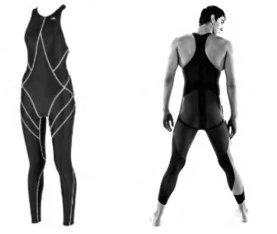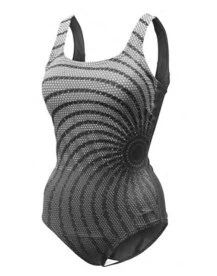The Analysis of Comfort of Swimsuit Materials
The clothing pressure of swimwear mainly comes from the restraint effect of swimsuit fabrics on the human body. The high-quality swimsuit fabric is soft, elastic, and resilient, and can be returned to its original state after repeated stretching; the fabric has a dense texture, delicate cutting, and elastic threads are used for sewing. The thread will not break due to a lot of movements. For example, the world's most expensive swimsuit named sharkskin, Speedo has launched 4 generations of swimsuits (Figure 2), of which the 4th generation uses the special material "LZR Pulse" which is extremely light, low resistant, waterproof and quick-drying. It is made by high-tech welding without wrinkles. It has become the best choice for breaking the world's record.
The main performance indicators of clothing pressure comfort are elastic elongation and elastic recovery rates. The tensile elastic elongation and tensile recovery rate of swimwear in GB/T 22852-2009 "Knitted Swimwear Fabrics" are shown in Table 2. The pressure comfort of swimwear can be predicted based on the elastic elongation and recovery rate of our most common swimsuit raw materials such as DuPont Lycra, Nylon, Polyester.

Figure 2 Sharkskin swimsuits
Table 2 Standards for knitted swimwear fabrics
The main performance indicators of clothing pressure comfort are elastic elongation and elastic recovery rates. The tensile elastic elongation and tensile recovery rate of swimwear in GB/T 22852-2009 "Knitted Swimwear Fabrics" are shown in Table 2. The pressure comfort of swimwear can be predicted based on the elastic elongation and recovery rate of our most common swimsuit raw materials such as DuPont Lycra, Nylon, Polyester.

Figure 2 Sharkskin swimsuits
Table 2 Standards for knitted swimwear fabrics
| Materials of swimwear | Stretch elastic elongation in vertical direction/% | Elastic elongation in transverse direction/% | Tensile elastic recovery rate/% |
| Superior products | Greater than and equal to 120 | Greater than and equal to 100 | Greater than and equal to 70 |
| First-class products | Greater than and equal to 100 | Greater than and equal to 80 | Greater than and equal to 65 |
| Qualified products | Greater than and equal to 80 | Greater than and equal to 70 | Greater than and equal to 60 |
DuPont Lycra
DuPont Lycra is polyester spandex produced by dry spinning. It is a man-made elastic fiber with good elasticity. The elastic elongation can reach 600% and the recovery rate is 100%. It is suitable for blending with other fibers. DuPont Caika swimsuits have a longer service life than ordinary swimsuits, and are mostly suitable for one-piece swimsuits. The international unified standard for the content of spandex in swimsuit fabrics is 18%, so that swimsuits can stretch freely with body movements. Referring to Table 2, it can be seen that DuPont Lycra meets the garment pressure standard in "Knitted Swimwear Fabrics".
Nylon
Nylon swimsuits have good strength and wear resistance. Compared with DuPont Caika swimsuits, swimsuits made of Nylon don't have good strength, but the elasticity and softness are comparable; the elastic recovery rate is above 75%. Nylon is the most used fabric.
Polyester
The most outstanding feature of polyester is that it has excellent elasticity and recovery. The elastic recovery rate of polyester can reach 100%, and it has good electrical insulation and chemical resistance. It is good for split-type swimsuits. The composition of high-quality swimsuit fabrics are generally nylon/spandex 80/20 (Figure 3) or nylon/hydrogen 78/22. The elastic elongation rate is 92% and elastic recovery rate is 84%, which can well adapt to the skin deformation in the dynamic process of the human body, balance the tension inside the fabric and the friction between the skin and the fabric. Increasing the content of elastic fibers such as spandex, using high-elasticity structures, and improving weaving technology can obtain better extensibility.

Figure 3 Spandex/Nylon 80/20 Swimsuit
At present, the evaluation of pressure comfort includes subjective evaluation and objective test evaluation. The subjective evaluation can enable the wearer to evaluate the pressure comfort of the clothing through the subjective feeling rating in the field, which more truly reflects the actual feeling of each wearer on the pressure and comfort of the clothing, but it is affected by the differences between individuals due to the influence of differences in mood and physiological factors; the evaluation results fluctuate greatly. Objective test evaluation is to use instruments to measure the pressure of clothing, and the measured data is processed and transformed into a pressure index for evaluating the pressure comfort of fabrics. This method is simple and easy to operate, but ignores the subjective feelings of the human body.
Conclusion
The generation of clothing pressure is the result of the combined effect of the physical properties of the fabric, the structural design of the clothing and the human body. At present, the research on the pressure comfort of swimsuits should not only be related to the extensibility, elastic modulus and bending properties of swimsuit fabrics under static conditions, but also carefully analyze every change in the movement of the body part in various postures of swimming in the dynamic process, and then carry out relevant clothing design according to these characteristics of the movement. Because the functionality of swimsuits is mainly reflected in the process of exercise, the pressure design of swimsuits should enable people to reduce resistance and move more freely in the water, which better reflects the correlation between people, clothing and the environment. However, the current research equipment, researcher experience and comprehensive prediction and analysis methods of clothing pressure comfort in dynamic aspects are still insufficient and need to be further improved.